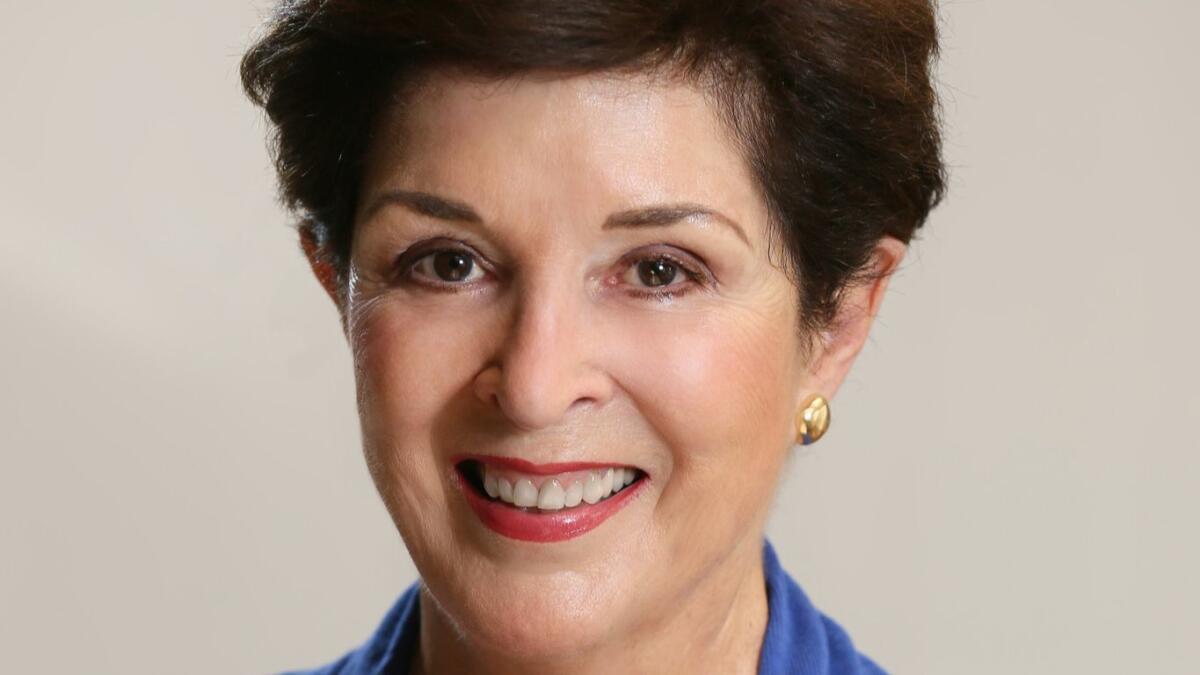Joan Graves, the MPAA’s longtime ratings chief, will retire next year

After 30 years of watching and grading the content of more than 12,500 movies for the Motion Picture Assn. of America, ratings board chair Joan Graves is calling it quits.
The 77-year-old grandmother of two will retire as chair of the Washington D.C-based trade group’s ratings arm next year, Chairman and Chief Executive Charles Rivkin said Wednesday. MPAA corporate counsel Kelly McMahon will succeed her after a transition period.
As head of the 50-year-old mysterious and oft-critiqued ratings system, Graves has wielded considerable influence over how parents decide what they let their kids watch in theaters, overseeing a nine-person group that assigns each film with one of five designations, ranging from G to NC-17.
That responsibility has often come with backlash, both from movie critics and filmmakers, over what determines the difference between a PG-13 and an R-rated movie.
But in an interview, the sharp-witted Graves said much of the criticism over the years has been overblown. A major goal of hers has been to demystify the process both for consumers and the people whose commercial success can be heavily swayed by a particular rating. One of her signature achievements, she said, has been the repairing of relationships with the directors whose films the board closely scrutinizes for every f-bomb uttered, every private part shown and every drug snorted.
“The biggest challenge was overcoming some of the animosity from filmmakers, and them thinking we were the enemy,” she said. “Opening communication with them has been something I’m most proud of.”
Graves, who lives in Brentwood, first joined the MPAA as a part-time rater in 1988, at a time when she was serving as a stay-at-home mother of two girls. She was promoted to the ratings board chair position in 2000.
She spearheaded key changes to the way ratings are determined,including the addition of descriptors to help parents understand the rationale for a particular R, PG-13 or PG rating. She also created the position of a liaison for filmmakers within the MPAA to help directors steer their projects toward a rating they — or their studio — desired.
In 2007, she sharpened the organization’s scrutiny of tobacco use as a factor in determining ratings, in response to parental concerns.
“She has improved the system dramatically over the last 30 years,” said Rivkin, who replaced former MPAA chief Chris Dodd last year. “She’s a true institution here.”
The ratings system — formally called the Classification and Rating Administration — was created in 1968 by former MPAA President and CEO Jack Valenti, who led the organization for decades. It was intended as a way for the industry to regulate itself in the wake of a dreaded production code that strictly censored what studios could show in movies. The MPAA has rated 29,791 movies.
Though Graves’ replacement McMahon, 45, has not served as a rater, she has long been close to the process, working at the MPAA for 11 years. Her experience overseeing the appeals board for the ratings has given her insight into the nuances of the system.
McMahon, based in MPAA’s L.A. office, said it’s too early to say how she might tweak the ratings system in the coming years, but acknowledged that the group will continue to adapt.
“The beauty of the system is that it’s designed to evolve with the times,” McMahon said. “Any changes we make will be based on talking to the parents.”
Ratings controversies have continued to flare up in recent years as filmmakers sometimes appealed NC-17 and R ratings in an effort to reach the largest audience possible.
But disputes are rare. MPAA said in its recent report that only 1.4% of movies it has rated have been appealed and 0.6% have been overturned. The last time the MPAA assigned an NC-17 — meaning no one 17 and under will be admitted — was in 2015.
“We don’t set standards, we reflect them,” Graves said. “The survey indicated we’ve been right on about the language.”
Graves admits getting some decisions wrong. Even her grown daughters occasionally disagree with MPAA ratings, asserting that a certain movie should have been PG-13 instead of PG, she said with a laugh.
Years ago, she recalls, a distraught parent called to complain that a certain movie (Graves wouldn’t say which one) had earned a PG rating, despite a scene in which a group of kids sniffed glue. Graves couldn’t retract or change the rating for the film, which had already hit theaters, but relayed the complaint to the studio, which cut the scene for the home video release.
Watching hundreds of movies a year with a cloistered group of parents has led Graves to make some quirky observations. Raters would often scarf popcorn during violent films, but would choose chocolate snacks when watching sexual content and, for some reason, bagels when they found a movie boring, she said.
She declined to name the movie she most disliked during her tenure, but she acknowledged a strong personal distaste for horror films with gratuitous violence, sadistic behavior and sexual assaults. One movie was so violent one of the raters lost consciousness and had to be taken away on a stretcher, she said.
Instead, she tends to prefer smaller films, ones that have emotional resonance and portray relationships in a thoughtful way. After retirement, she plans to spend more time with her grandkids (ages 5 and 7), gardening and traveling. She wants to keep watching movies, but without taking notes. “I’m still a movie lover,” she said.
More to Read
Inside the business of entertainment
The Wide Shot brings you news, analysis and insights on everything from streaming wars to production — and what it all means for the future.
You may occasionally receive promotional content from the Los Angeles Times.







